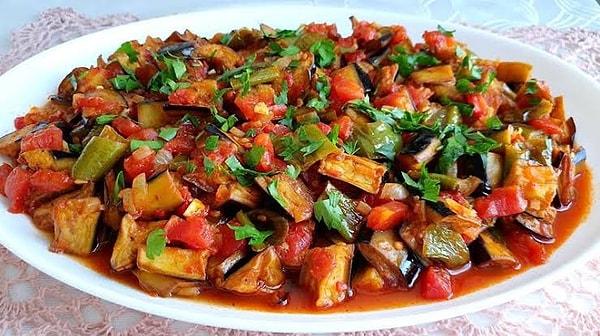Shakshuka: A Culinary Journey Through Time and Taste

Shakshuka. The very word conjures images of bubbling, vibrant red sauce, speckled with the golden yolks of eggs, nestled in a skillet and ready to be devoured. More than just a breakfast dish, shakshuka is a testament to culinary fusion, a vibrant tapestry woven from threads of diverse cultures and traditions. Its simple yet deeply satisfying nature has propelled it from the kitchens of North Africa and the Middle East to become a global phenomenon, gracing brunch menus from Melbourne to Manhattan. This article delves into the fascinating history, regional variations, and culinary artistry of this beloved dish.
A History Steeped in Spices and Tradition:
Pinpointing the precise origins of shakshuka is a task fraught with scholarly debate. Its name itself offers a clue, with many believing it derives from the Arabic word "shakashuka," meaning "all mixed up," a fitting description of the dish’s heterogeneous ingredients. However, the dish’s roots are deeply embedded in the culinary landscapes of North Africa and the Middle East, where the use of eggs with rich tomato-based sauces has existed for centuries.
Some scholars trace shakshuka’s lineage back to the Ottoman Empire, where similar egg and tomato preparations were common. The influence of Jewish communities in these regions is also significant, with many variations incorporating spices and techniques passed down through generations. The presence of shakshuka in various forms across countries like Tunisia, Morocco, Libya, Egypt, and Israel further underscores its long and diverse history, highlighting the cross-cultural exchange that shaped its evolution.
The dish’s journey to international acclaim is relatively recent. Its popularity has surged in the past few decades, propelled by the growing interest in global cuisines and the increasing accessibility of ingredients. Food blogs, social media, and celebrity chefs have all played a crucial role in bringing shakshuka into the mainstream, transforming it from a regional specialty to a globally recognized culinary icon.
Regional Variations: A Kaleidoscope of Flavors:
While the core components of shakshuka—eggs poached in a spicy tomato sauce—remain constant, regional variations offer a fascinating exploration of culinary diversity. Each region boasts its own unique spin on this classic dish, reflecting the local availability of ingredients and established culinary traditions.
North African Shakshuka: Often featuring a spicier sauce, North African versions frequently incorporate harissa paste, a fiery chili paste that provides a characteristically intense heat. The addition of cumin, coriander, and paprika further enhances the depth of flavor, creating a rich and complex sauce. Sometimes, olives, preserved lemons, or other regional ingredients are added for an extra layer of complexity.
Middle Eastern Shakshuka: Middle Eastern variations often incorporate a wider range of spices, such as turmeric, cardamom, and cinnamon. The sauce may be slightly sweeter, with the addition of onions, garlic, and bell peppers contributing to a more nuanced flavor profile. The use of fresh herbs, like parsley or cilantro, is common, adding a vibrant freshness to the dish.
Israeli Shakshuka: Israeli shakshuka is perhaps the most widely recognized variation globally. It often features a simpler sauce, with a focus on fresh tomatoes, onions, and peppers. The spices are typically more restrained, allowing the natural flavors of the ingredients to shine through. The eggs are usually poached gently, resulting in runny yolks that are perfect for dipping with bread.

Beyond the Basics: Creative Adaptations:
The beauty of shakshuka lies in its adaptability. The basic recipe serves as a springboard for endless creative explorations, allowing cooks to personalize the dish to their liking. Adding different vegetables, cheeses, meats, or even seafood can transform shakshuka into a completely new culinary experience.
Vegetarian and Vegan Variations: The omission of meat presents no challenge to the dish’s deliciousness. Adding vegetables like spinach, mushrooms, or zucchini provides a hearty and nutritious vegetarian option. Vegan versions often utilize plant-based substitutes for eggs, achieving a surprisingly similar texture and flavor.
Spicy Shakshuka: For those who appreciate a fiery kick, increasing the amount of chili flakes or adding a generous dollop of harissa paste will elevate the heat level to a satisfyingly intense degree.
Creamy Shakshuka: A dollop of crème fraîche, Greek yogurt, or even a sprinkle of feta cheese can add a creamy texture and tangy flavor, balancing the richness of the tomato sauce.

Gourmet Shakshuka: Adding gourmet ingredients such as smoked paprika, roasted red peppers, or truffle oil can transform shakshuka into a sophisticated and elegant dish, suitable for special occasions.
The Art of Cooking Shakshuka: A Simple Yet Satisfying Process:
The process of making shakshuka is remarkably straightforward, even for novice cooks. The key lies in building layers of flavor and allowing the sauce to simmer gently, allowing the flavors to meld and deepen.
The Sauce: The foundation of any good shakshuka is a well-made sauce. Sautéing onions and garlic in olive oil before adding the tomatoes creates a flavorful base. Adding spices at this stage ensures they are fully infused into the sauce. Simmering the sauce for at least 15-20 minutes allows the flavors to develop fully, resulting in a rich and complex taste.
Poaching the Eggs: Gently cracking the eggs into the simmering sauce is crucial. Avoid overcrowding the pan, as this will result in unevenly cooked eggs. Covering the pan allows the eggs to cook gently in the steam, resulting in perfectly runny yolks.

Serving and Enjoying: Shakshuka is best served immediately, while the eggs are still warm and the sauce is bubbling. Serving it with crusty bread or pita is essential for soaking up the delicious sauce. A sprinkle of fresh herbs, a dollop of yogurt, or a drizzle of olive oil adds the finishing touches.
Shakshuka: More Than Just a Dish; A Culinary Experience:
Shakshuka is more than just a recipe; it’s a culinary journey, a testament to the power of simple ingredients combined with skillful technique. Its rich history, diverse regional variations, and endless possibilities for customization make it a dish that continues to captivate and inspire cooks worldwide. Whether enjoyed as a hearty breakfast, a comforting lunch, or a vibrant dinner, shakshuka offers a unique and satisfying culinary experience that transcends cultural boundaries. Its popularity is a testament to its inherent deliciousness and its ability to adapt and evolve, reflecting the ever-changing culinary landscape. So, gather your ingredients, embrace the process, and embark on your own shakshuka adventure – you won’t be disappointed.

Video tentang Shakshuka: A Culinary Journey Through Time and Taste
Penutup
Therefore, we hope this article has provided valuable insights on Shakshuka: A Culinary Journey Through Time and Taste. We hope you found this article informative and helpful. See you in our next article!

